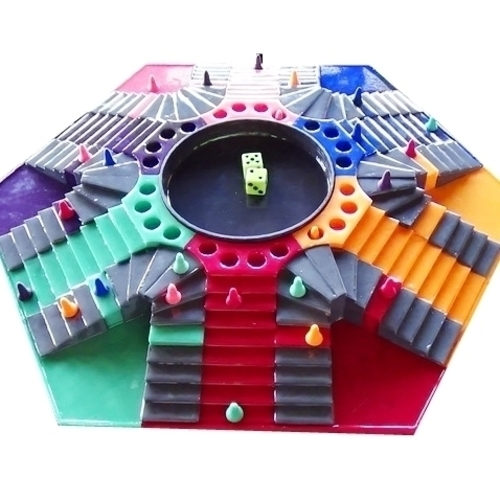
Parchis
pinshape
GAME MECHANICS There is no official regulation of the parquet and in different regions there are various variants, which will be stated later. All players start with their chips locked up in respective jailhouses. The first turn is chosen by rolling dice: the player who draws the largest number gets to start the game. Next, you have three opportunities to get your chips out of jail and drag them to the starting square. You take out chips with pairs or presadas, that is, when both dice show the same value. For example, 1-1 and 3-3 are pairs or presadas, which in other games such as Parcheesi are called doubles. The 1-1 or 6-6 pairs draw all your chips from jail; the rest, like 3-3, take only two. There is a variation to this rule, which must be agreed upon at the beginning of the game: If you roll 1-1 or 6-6 on the dice, you can take out two chips from jail, if you want, and in this case you will have the option of moving one of your tiles the value that has a die, that is, move 1 or move 6. However, this is an unusual variation of the game. The Parqués board at the beginning of the game, with 6 players locked up in jail. If you can draw a chip, you must roll again, move and pass your turn. To move your tiles, you simply have to drag them to their destination position by counting the squares you have to move. If you are at the start and take 5-2, for example, you can advance one chip to the insurance box or move 5 with one and 2 with the other. Next, it's time to pass your turn. The only way to get an extra turn is by rolling pairs. If you roll 3 pairs, you have the right to take a chip from the game, the one that the player chooses, which is usually the most backward. Your turn then passes to the player on your right, unlike Parchís, who does it on the left. After getting out of jail, the game continues in the manner described above. The mechanics of the game continue in this way until a player takes all their chips to the final square. At that time, you will have won the game. A player can send an opponent to jail. To do so, you must move one tile to the square where the other tile is. Immediately, send the opponent's chip to jail. However, if the chip is in an insurance or exit box, nothing special happens. There is another way to send to jail that is used as a strategy: when a player has one or more chips locked up and there are chips of an opponent in their exit box, if they take out their chips from jail, they automatically send them to the corresponding jail. It's a useful strategy when there are more than 1 chip in the player's exit; you can sacrifice a chip in the hope that the opponents' chips won't be able to escape before you do. In some cases, the pateperro is used, which is obtained when the dice show 2-1 to eat backwards. The idea is to advance all your chips from the starting space to the end before your opponents do so. To fulfill this objective, the player must start by taking out all their chips from jail and then make them take a complete tour of the board in the counter-clockwise direction, that is, on the right, preventing their chips from being returned to prison by their opponents, until they reach arrival boxes exclusive to each player, located just before their respective exit boxes. The arrival boxes lead to the center of the board, which is where the final square is located. The player cannot have any tile in the four boxes after the insurance boxes (arrival calls) until before their own departure box. There is a variation in which the player can choose to turn around or is simply forced to do so if they can eat in those boxes. See variations section later. TOTAL SIZE: The board measures 50 x 50 centimeters and is 5.3 cm high ATTACHED FILES: Given (x2), Tab (x6), Colored steps (x6), Base color (x6), Curved step (x6), Curved step dr. (x6), Straight step (x12), Pot (x1) The chip file is assembled by 6 units to have 2 leftovers in case of loss to have the replacement of the same color. The individual file is also available to print as needed. 3D printing parameters None of the pieces requires support. Wall thickness: 1.2 mm higher Print speed: 70 mm/s Filling: 20% Layer height: 0.25 mm or less Plate adhesion: not required
With this file you will be able to print Parchis with your 3D printer. Click on the button and save the file on your computer to work, edit or customize your design. You can also find more 3D designs for printers on Parchis.
